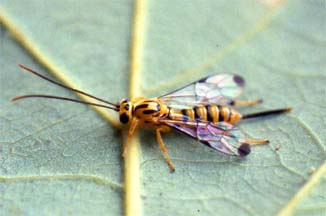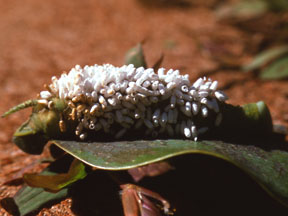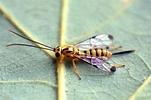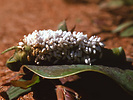Ichneumonoidea
James B. Whitfield


This tree diagram shows the relationships between several groups of organisms.
The root of the current tree connects the organisms featured in this tree to their containing group and the rest of the Tree of Life. The basal branching point in the tree represents the ancestor of the other groups in the tree. This ancestor diversified over time into several descendent subgroups, which are represented as internal nodes and terminal taxa to the right.

You can click on the root to travel down the Tree of Life all the way to the root of all Life, and you can click on the names of descendent subgroups to travel up the Tree of Life all the way to individual species.
For more information on ToL tree formatting, please see Interpreting the Tree or Classification. To learn more about phylogenetic trees, please visit our Phylogenetic Biology pages.
close boxIntroduction
The Ichneumonoidea comprises a huge group (over 100,000 estimated species worldwide) of primarily parasitoid insects that attack other arthropods, especially the immature stages of other insects (Gauld and Bolton, 1988; Wahl and Sharkey, 1993). A few taxa are secondarily phytophagous, and several groups that attack egg masses or food provisions of other arthropods are difficult to classify as either "parasitic", predaceous or parasitoid. The species of Ichneumonoidea vary tremendously in size, from approximately 1 mm in length to 5-6 cm (even larger if the ovipositor of some larger species is included).
The superfamily currently is considered to contain two extant families, Braconidae and Ichneumonidae, as well as one fossil family (Eoichneumonidae), and a fossil genus, Tanychora, of uncertain relationship to the other families (Sharkey and Wahl, 1992). Past classifications have sometimes included other groups, such as Stephanidae and Megalyridae, now transferred elsewhere, or they have recognized subfamilies of Braconidae (e. g. Aphidiinae and Apozyginae) and Ichneumonidae (Agriotypinae and Paxylommatinae) as distinct families.
Ichneumonoidea have been present since at least the early Cretaceous, being represented by Tanychora from Transbaikalia (Townes, 1973), as well as several genera of Eoichneumonidae from Australia, Siberia and Mongolia (Jell and Duncan, 1986; Rasnitsyn and Sharkey, 1988). The placements of the early Cretaceous Praeichneumon townesi as an ichneumonoid and of Eobracon inopinatus as a braconid (Rasnitsyn, 1983) have been questioned recently (Sharkey and Wahl, 1992; Whitfield, 2002); nevertheless it is clear that the superfamily was still represented at least by extinct groups from the very early Cretaceous.
Discussion of Phylogenetic Relationships
Sharkey and Wahl (1992) presented the first real cladistic analysis of the fossil and extant families; their tree is represented on this page as the reference tree. Readers may also want to consult the more recent analyses and discussions of Quicke et al. (1999) for a more updated (if slightly more phylogenetically inconclusive) review.
References
Gauld, I. and B. Bolton. 1988. The Hymenoptera. British Museum (Natural History) and Oxford Univ. Press.
Jell, P. A. and P. M. Duncan. 1986. Invertebrates, mainly insects, from the freshwater, Lower Cretaceous, Koonwarra Fossil Bed (Korumburra Group), South Gippsland, Victoria. Mem. Assoc. Australas. Paleaont. 3: 111-205.
Quicke, D. L. J., H. H. Basibuyuk, M. G. Fitton and A. P. Rasnitsyn. 1999. Morphological, palaeontological and molecular aspects of ichneumonoid phylogeny (Hymenoptera, Insecta). Zool. Scripta 28: 175-202.
Rasnitsyn, A. P. 1983. Ichneumonoidea (Hymenoptera) from the lower Cretaceous of Mongolia. Contrib. Amer. Entomol. Inst. 20: 259-265.
Rasnitsyn, A. P. and M. J. Sharkey. 1988. New Eoichneumonidae from the early Cretaceous of Siberia and Mongolia (Hymenoptera: Ichneumonoidea). Pp. 169-197 in: Gupta, V. K., ed., Advances in Parasitic Hymenoptera Research, E. J. Brill, Leiden.
Sharkey, M. J. and D. B. Wahl. 1992. Cladistics of the Ichneumonoidea (Hymenoptera). J. Hymenopt. Res. 1: 15-24.
Townes, H. 1973. Two ichneumonids (Hymenoptera) from the early Cretaceous. Proc. Entomol. Soc. Wash. 75: 216-219.
Wahl, D. B. and M. J. Sharkey. 1993.Superfamily Ichneumonoidea. Pp. 358-509 in: Goulet, H. and J. T. Huber, eds., Hymenoptera of the World: An Identification Guide to Families, Agriculture Canada, Ottawa.
Whitfield, J. B. 2002. Estimating the age of the polydnavirus/braconid wasp symbiosis. Proc. Nat. Acad. Sci. USA 99: 7508-7513.
Title Illustrations

| Scientific Name | Toxophoroides sp. (Ichneumonidae: Lycorininae) |
|---|---|
| Location | Cardareva State Forest, Missouri |
| Specimen Condition | Live Specimen |
| Sex | Female |
| Life Cycle Stage | Adult |
| Body Part | habitus |
| Image Use |
 This media file is licensed under the Creative Commons Attribution-NonCommercial License - Version 3.0. This media file is licensed under the Creative Commons Attribution-NonCommercial License - Version 3.0.
|
| Copyright |
© 2004 James B. Whitfield

|
About This Page
James B. Whitfield

University of Illinois Urbana, Illinois, USA
Correspondence regarding this page should be directed to James B. Whitfield at
Page copyright © 2004 James B. Whitfield
 Page: Tree of Life
Ichneumonoidea.
Authored by
James B. Whitfield.
The TEXT of this page is licensed under the
Creative Commons Attribution License - Version 3.0. Note that images and other media
featured on this page are each governed by their own license, and they may or may not be available
for reuse. Click on an image or a media link to access the media data window, which provides the
relevant licensing information. For the general terms and conditions of ToL material reuse and
redistribution, please see the Tree of Life Copyright
Policies.
Page: Tree of Life
Ichneumonoidea.
Authored by
James B. Whitfield.
The TEXT of this page is licensed under the
Creative Commons Attribution License - Version 3.0. Note that images and other media
featured on this page are each governed by their own license, and they may or may not be available
for reuse. Click on an image or a media link to access the media data window, which provides the
relevant licensing information. For the general terms and conditions of ToL material reuse and
redistribution, please see the Tree of Life Copyright
Policies.
- First online 10 June 2004
- Content changed 30 November 2003
Citing this page:
Whitfield, James B. 2004. Ichneumonoidea. Version 10 June 2004 (under construction). http://tolweb.org/Ichneumonoidea/11174/2004.06.10 in The Tree of Life Web Project, http://tolweb.org/









 Go to quick links
Go to quick search
Go to navigation for this section of the ToL site
Go to detailed links for the ToL site
Go to quick links
Go to quick search
Go to navigation for this section of the ToL site
Go to detailed links for the ToL site